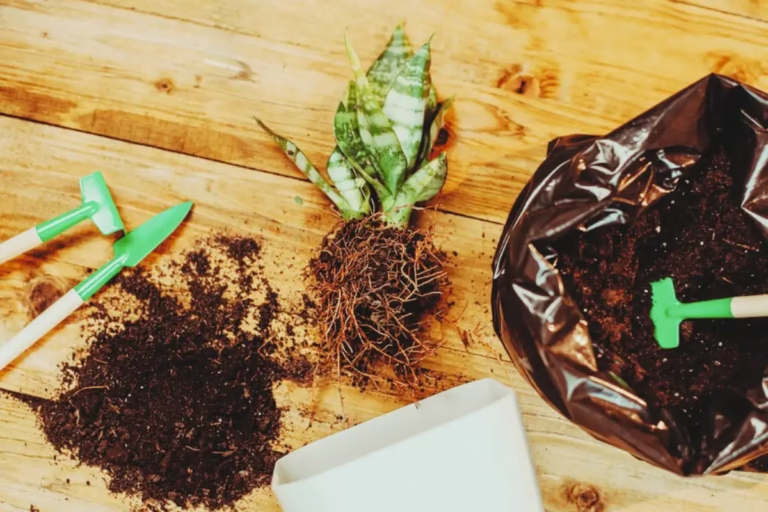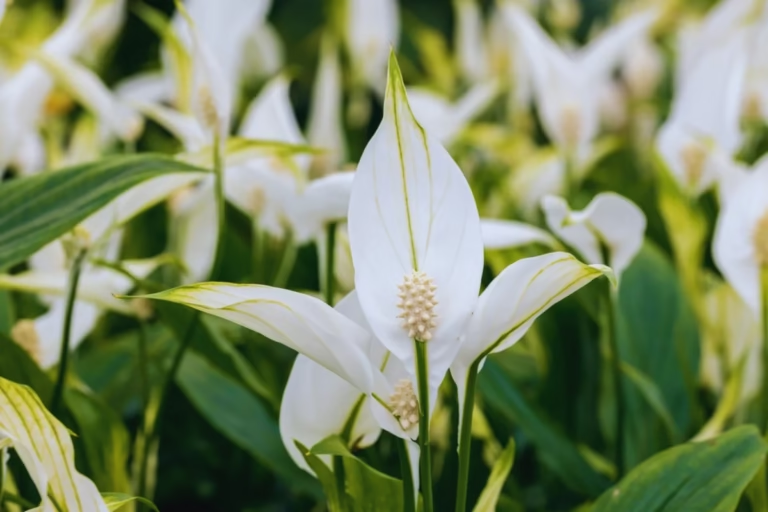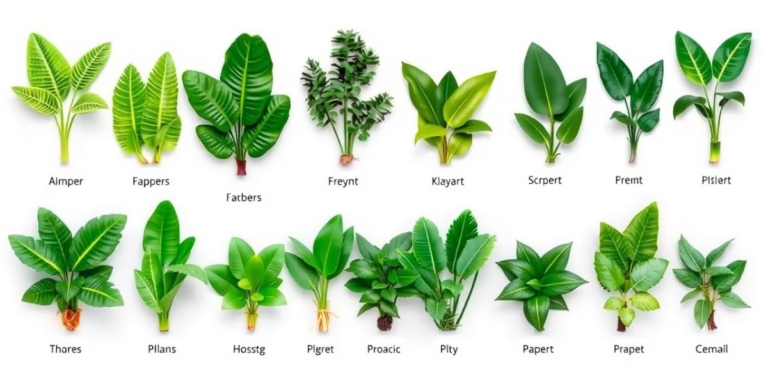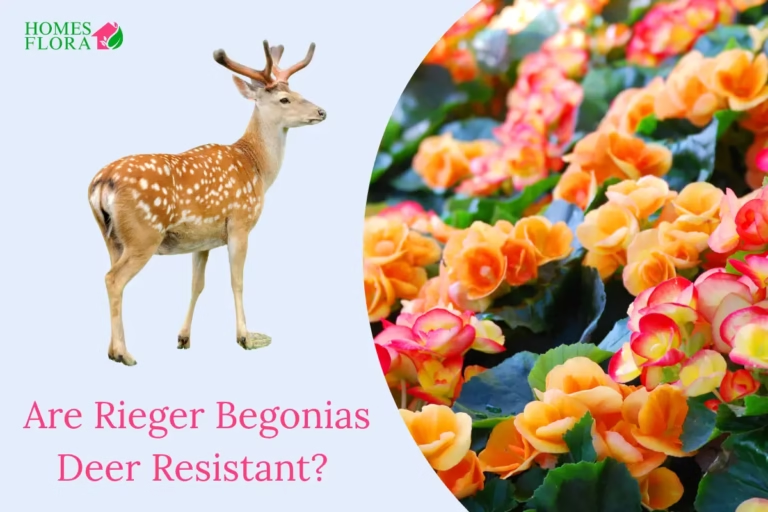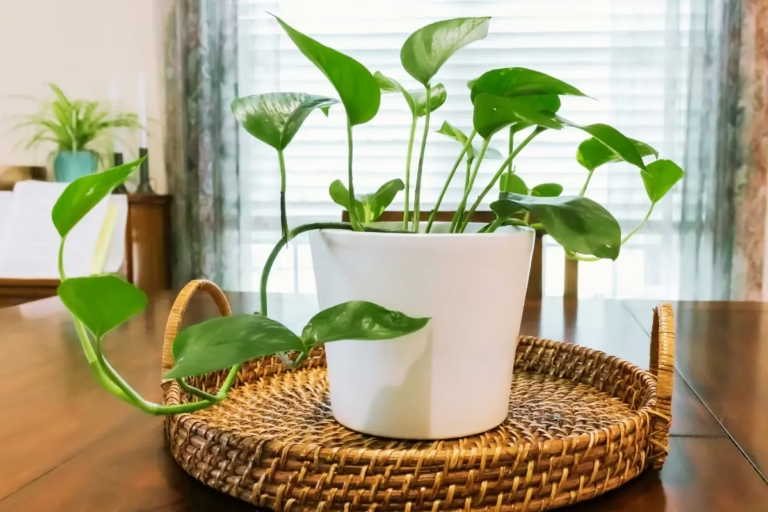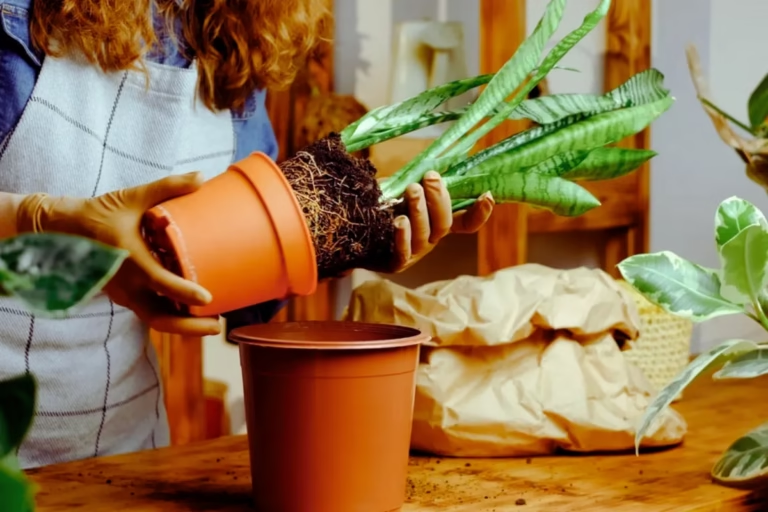Plants That Start With A: Indoor and Outdoor Garden List
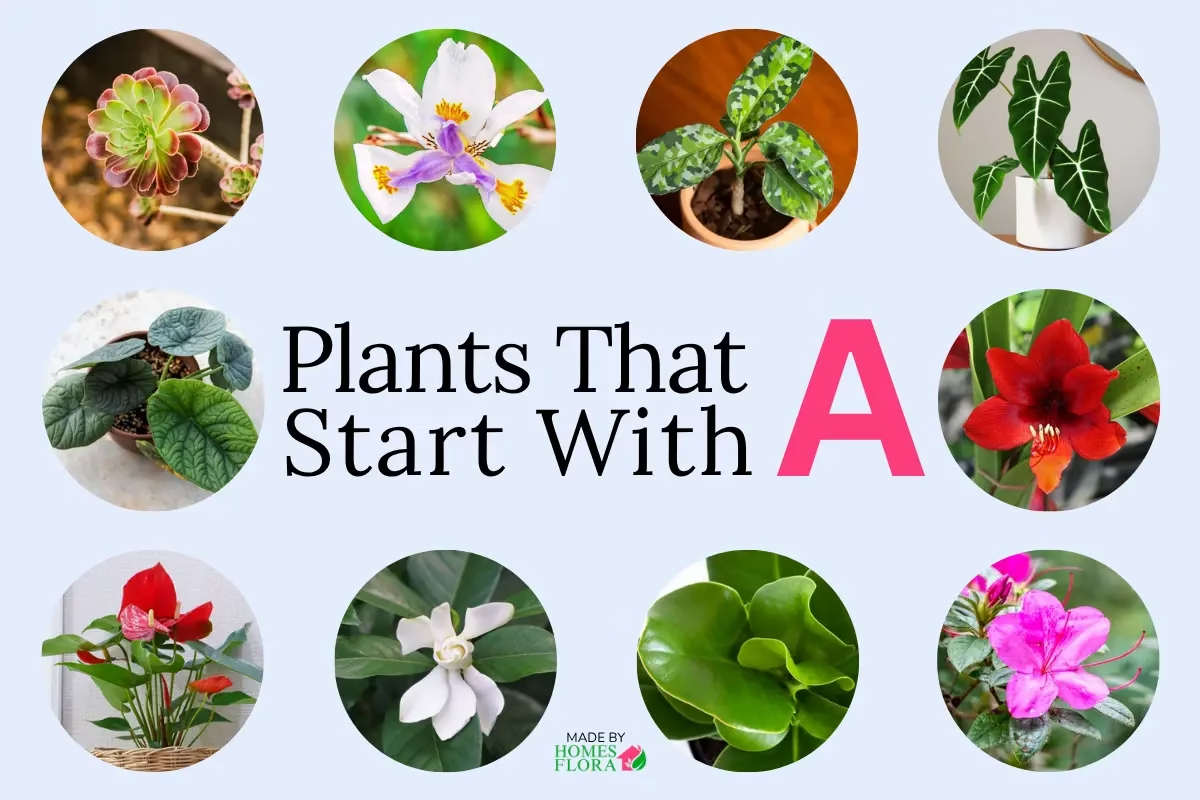
With thousands of plant species out there, starting alphabetically is a simple and engaging way to explore them. This list focuses on indoor and outdoor plants that start with A—featuring everything from tropical houseplants like Alocasia and Anthurium to garden favorites like Asters, Agapanthus, and Azaleas. Whether you’re decorating your home or planning your next landscape, these “A” plants offer beautiful, beginner-friendly inspiration.
List of Plants That Start With A (Indoor + Outdoor)
Here’s a handpicked mix of stunning houseplants and hardy outdoor picks — all starting with the letter “A.” From statement Alocasias to flowering Azaleas and aromatic herbs, this list has something for every plant lover.
- Aeonium
- Agapanthus
- Alocasia Black Velvet
- African Daisy
- Arrowhead Vine
- Aloe Ferox
- Amaryllis
- Alocasia Frydek
- Ajuga
- Alocasia Silver Dragon
- Agastache
- Apple Mint
- Alocasia ‘Tiny Dancer’
- African Spear Plant
- Anthurium
- Areca Palm
- Aglaonema pictum tricolor
- Artemisia
- Alocasia azlanii
- Abelia
- Alocasia Jacklyn
- Australian Tree Fern
- Autograph Tree
- Alocasia Dragon Scale
- Anise Hyssop
- Asiatic Jasmine
- African Iris
- Arrowwood Viburnum
- Alocasia Maharani
- Alocasia Stingray
- Azalea
- Alocasia Melo
- African Milk Tree
- Arugula
- Alocasia Odora
- Anemone
- Alocasia Pink Dragon
- Amber Jubilee Ninebark
- Angelica
- Agave
- American Ginseng
- Astilbe
- Alocasia
- Amaranth
- Asters
- Annabelle Hydrangea
- Anaheim Pepper
- American Elderberry
- Aluminum Plant
- Autumn Fern
- Aronia
- Autumn Sage
- Arabian Jasmine
- Aubrieta
- Asiatic Lily
- Asparagus Fern
- Asparagus
Prefer to skip ahead? Use the Table of Contents below to jump straight to your favorite plant profiles and explore them in detail.
List Of Indoor Plants That Begin with Letter “A”
From air-purifying foliage to sculptural statement pieces, indoor plants that start with A bring beauty and function into your home. This curated list includes compact tropical, quirky succulents, and easy-care houseplants—each selected to thrive in containers, brighten interiors, and elevate your indoor plant collection.
Indoor Plants Table: A-Category Picks
Plant Name | Scientific Name | Key Info |
|---|---|---|
Aeonium | Aeonium spp. | Succulent rosettes; needs bright, indirect light |
African Spear Plant | Dracaena angolensis | Drought-tolerant, upright cylindrical leaves |
Aglaonema pictum tricolor | Aglaonema pictum | Rare camouflage foliage; low light tolerant |
Alocasia | Alocasia spp. | Bold foliage; needs humidity and indirect light |
Alocasia ‘Tiny Dancer’ | Alocasia hybrid | Compact and quirky; good for small indoor spaces |
Alocasia azlanii | Alocasia azlanii | Iridescent leaves with purple tones |
Alocasia Silver Dragon | Alocasia baginda ‘Silver Dragon’ | Dramatic silver leaves with deep veins |
Alocasia Black Velvet | Alocasia reginula | Velvet-textured leaves; prefers moderate humidity |
Alocasia Dragon Scale | Alocasia baginda | Thick, textured foliage; likes moist soil |
Alocasia Frydek | Alocasia micholitziana | Velvety, arrow-shaped leaves; bright, indirect light |
Alocasia Jacklyn | Alocasia tandurusa | Unusual jagged leaves; collector favorite |
Alocasia Stingray | Alocasia macrorrhiza ‘Stingray’ | Stingray-shaped leaves; fast-growing |
Alocasia Maharani | Alocasia hybrid | Compact, thick foliage; needs high humidity |
Alocasia Melo | Alocasia rugosa | Rare, stone-like leaves; prefers well-drained soil |
Alocasia Odora | Alocasia odora | Large elephant-ear leaves; can grow tall indoors |
Alocasia Pink Dragon | Alocasia lowii | Pink stems with glossy green leaves |
Aluminum Plant | Pilea cadierei | Silvery patterned leaves; easy care |
Amaryllis | Hippeastrum spp. | Popular holiday bloomer; giant trumpet flowers |
Anthurium | Anthurium andraeanum | Heart-shaped blooms; air purifying |
Areca Palm | Dypsis lutescens | Air-purifying; thrives in bright, indirect light |
Arrowhead Vine | Syngonium podophyllum | Fast-growing trailing plant; easy to propagate |
Asparagus Fern | Asparagus aethiopicus | Feathery foliage; drought-tolerant once established |
Autograph Tree | Clusia rosea | Thick leaves you can “etch”; low-maintenance indoor shrub |
Aeonium
- Scientific Name: Aeonium spp.
- Common Names: Tree houseleek, Aeonium
- Mature Size: 3–36 inches tall, 6–12 inches wide
- Flower Color: Pink (small, star-shaped clusters)
- Plant Type: Succulent (perennial, slow-growing)
- Native Area: Canary Islands, parts of North Africa
- Hardiness Zones: USDA 9–11
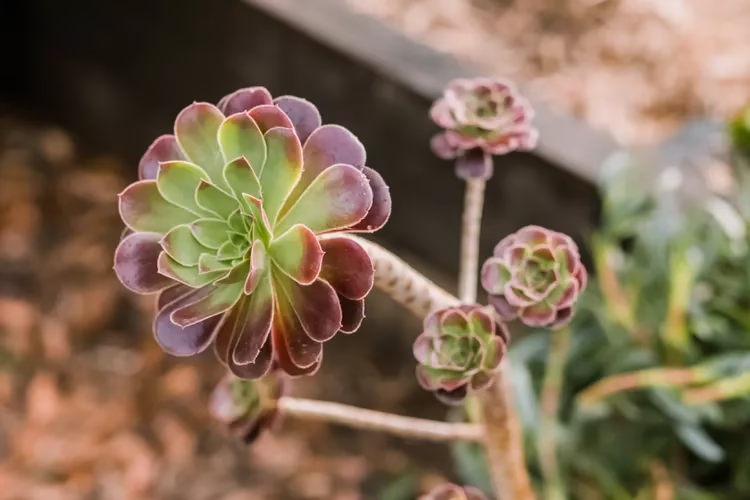
Aeonium is a sculptural succulent known for its waxy, geometric rosettes that resemble floral art. Perfect for minimalist or modern interiors, it adds architectural contrast with its symmetrical foliage and multicolored leaf forms. As one of the standout Plants that start with the letter A, Aeonium thrives indoors where it gets bright indirect light, lending homes a desert-chic elegance with minimal upkeep.
African Spear Plant
- Scientific Name: Dracaena angolensis
- Common Names: Cylindrical snake plant, spear sansevieria
- Mature Size: 4–6 ft tall, 1–2 ft wide
- Family: Dracaena
- Flower Color: White
- Plant Type: Succulent
- Native Area: Africa
- Hardiness Zones: 10–11 (USDA)
:max_bytes(150000):strip_icc():format(webp)/grow-sansevieria-cylindrica-1902732-HERO-d9060791adcf4da49270b3413c527be6.jpg)
The African spear plant displays striking, spear-shaped leaves with subtle gray-green stripes, adding vertical architectural interest to interiors or outdoor spaces. Its sculptural form enhances modern decor, symbolizing resilience and endurance. This plant is an excellent choice among Plant that starts with A for those seeking bold, drought-tolerant greenery that complements minimalist or tropical design theme.
Aglaonema pictum tricolor
- Botanical Name: Aglaonema pictum tricolor
- Common Names: Camouflage plant, Chinese evergreen
- Mature Size: 2 ft. (indoors)
- Family: Araceae
- Flower Color: Green, white
- Plant Type: Perennial shrub
- Native Area: Asia
- Hardiness Zones: 10–12 (USDA)
:max_bytes(150000):strip_icc():format(webp)/SPR-aglaonema-pictum-tricolor-care-guide-03-75c7688365654a83adb64a4f0a9d8ac2.jpg)
Aglaonema pictum tricolor dazzles with its glossy, camouflaged leaves showcasing three distinct greens, adding a unique texture to indoor spaces. Its tropical charm and rich variegation bring natural elegance, perfect for enhancing modern interiors or shaded garden corners. This plant stands out among Plants start with letter A for its beauty and subtle sophistication.
Alocasia
- Botanical Name: Alocasia spp.
- Also Called: Elephant’s ear, African mask
- Plant Height: 2–10 ft.
- Plant Family: Araceae
- Flower Hue: Yellow
- Type Form: Herbaceous perennial
- Native Region: Asia
- Zone Suitability: USDA 10–12

With bold, sculptural leaves and a fast-growing habit, Alocasia brings a dramatic tropical accent to interior spaces. Among Plants that start with an A, it stands out for its exotic patterning and strong vertical form, making it a statement piece in well-lit rooms.
Related: Plants That Start With B (Indoor & Outdoor Favorites)
Alocasia ‘Tiny Dancer’
- Botanical Title: Alocasia ‘Tiny Dancer’
- Nickname: Tiny dancer alocasia
- Growth Height: 14–20 inches
- Plant Class: Corm-type perennial
- Origin Place: Southeast Asia
- Light Preference: Filtered sun
- Climate Zone: USDA 10–11

Alocasia ‘Tiny Dancer’ adds quirky character with its curving stems and upright leaves—ideal for tight indoor spaces. This whimsical choice from Plants beginning with the letter A excels in terrariums or small pots, thriving in warmth and humidity with minimal pruning needs.
Alocasia azlanii
- Scientific Name: Alocasia azlanii
- Other Names: Red Mambo, Jewel Alocasia
- Height at Maturity: ~12 inches
- Growth Habit: Subtropical perennial
- Native Range: Asia, Eastern Australia
- Preferred Light: Bright indirect
- USDA Zones: 7–11

A rare gem among Plants that begin with the letter A, Alocasia azlanii dazzles with metallic foliage in deep purples, greens, and reds. Compact yet bold, it thrives in warm, humid spaces and adds a luxe botanical accent to modern indoor decor.
Alocasia Silver Dragon
- Botanical Name: Alocasia baginda ‘Silver Dragon’
- Known As: Silver Dragon Alocasia
- Plant Family: Araceae
- Growth Size: Up to 3 feet
- Lighting Needs: Dappled or indirect sun
- Native Origin: Southeast Asia
- Cold Hardiness: Zones 9–11

With its thick, scale-like silver foliage and compact structure, this tropical beauty adds a mystical accent to shaded interiors. Its rare texturing makes it a crown jewel among Plant that starts with an A, delivering drama without overwhelming space.
Alocasia Black Velvet
- Botanical Name: Alocasia reginula
- Also Known As: Black Velvet Elephant Ear
- Plant Family: Araceae
- Mature Size: Up to 1.5 feet
- Sunlight Needs: Bright, indirect light
- Native Range: Southeast Asia
- USDA Zones: 10 and up
This jewel-like alocasia stuns with velvety dark foliage veined in silver, offering dramatic texture for compact spaces. A slow grower but high on visual impact, it stands out among Plants beginning with A, especially for collectors seeking tropical depth and moody elegance.
Alocasia Dragon Scale
- Botanical Name: Alocasia baginda ‘Dragon Scale’
- Common Names: Dragon Scale Alocasia
- Plant Family: Araceae
- Mature Size: 2–3 ft. tall
- Light Requirements: Bright, indirect light
- Soil Type: Moist, well-drained, airy mix
- Native Range: Borneo, Southeast Asia
- Hardiness Zones: USDA 9–11

Gleaming with sculptural beauty, Dragon Scale Alocasia lives up to its mythical name—its deeply veined leaves evoke dragon hide and elevate any indoor jungle. Among prized Indoor plants that start with A, it symbolizes rarity, strength, and bold botanical artistry.
Alocasia Frydek
- Botanical Name: Alocasia micholitziana ‘Frydek’
- Common Names: Green Velvet Alocasia, Elephant’s Ear
- Plant Family: Araceae
- Mature Size: 2–3 ft. tall
- Light Needs: Bright, indirect light
- Soil Type: Chunky, moist, well-draining mix
- Native Range: Southeast Asia (Philippines)
- Hardiness Zones: USDA 9–11
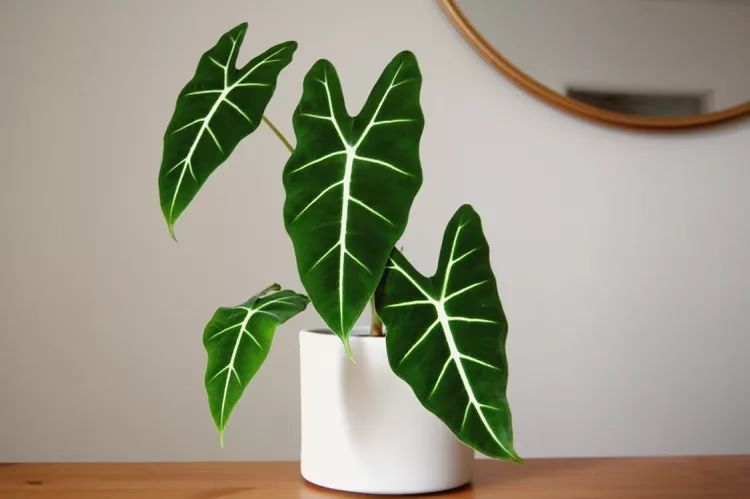
Velvety dark leaves veined in crisp white give Alocasia Frydek a bold, graphic elegance. As one of the striking Plants starting with A, it brings a rainforest feel indoors—symbolizing resilience and refined beauty when nurtured with warmth and humidity.
Alocasia Jacklyn
- Botanical Name: Alocasia sulawesi, Alocasia tandurusa
- Common Names: Alocasia Jacklyn
- Family: Araceae
- Plant Type: Perennial, tuberous
- Mature Size: 5–8 ft. tall, 4 ft. wide
- Native Area: Asia (Indonesia)
- Toxicity: Toxic to humans and pets

Alocasia Jacklyn boasts striking, deeply lobed leaves shaped like a stag’s head, making it a captivating Plants beginning with letter “A” perfect for tropical indoor collections. Its dramatic foliage symbolizes strength and uniqueness, requiring warm, humid conditions and indirect light to thrive beautifully indoors.
Alocasia Stingray
- Botanical Name: Alocasia macrorrhiza ‘Stingray’
- Common Name: Alocasia stingray
- Family: Araceae
- Plant Type: Perennial, corm
- Mature Size: 3–4 ft. tall (indoors)
- Sun Exposure: Partial, indirect
- Soil Type: Moist, well-drained
- Native Area: Asia
- Toxicity: Toxic to pets

With leaves that curl and flick like the tail of a stingray, this bold foliage plant adds exotic charm to interiors. A fast-growing Plant starting with the letter “A” tropical flair, Alocasia Stingray thrives in warmth and humidity, making it ideal for bright bathrooms or sun-filtered spaces.
Alocasia Maharani
- Botanical Name: Alocasia maharani
- Common Names: Alocasia grey dragon, African mask maharani
- Family: Araceae
- Plant Type: Perennial, corm
- Mature Size: Up to 14 in. tall (indoors)
- Sun Exposure: Bright, indirect light
- Soil Type: Moist, well-drained
- Native Area: Asia
- Toxicity: Toxic to pets

Alocasia Maharani, a prized jewel alocasia, blends sculptural elegance with ease of care. Its gray-green, dragon-like foliage adds bold texture to small interiors, while thriving in indirect light and moderate humidity. A rare yet manageable Plants listed under letter A, it’s perfect for collectors seeking compact exotic beauty.
Alocasia Melo
- Scientific Name: Alocasia melo
- Also Known As: Alocasia rugosa
- Family: Araceae
- Plant Type: Perennial, herbaceous
- Mature Size: 15–20 in. tall
- Sun Needs: Bright, indirect light
- Soil Type: Loamy, well-drained
- Native Area: Asia
- Toxicity: Toxic to pets and humans

With its thick, sculptural leaves and rich stone-like texture, Alocasia Melo brings rare elegance to compact indoor spaces. As a humidity-loving Alphabet A plant variety, it’s perfectly suited for steamy bathrooms where warmth and filtered light mimic its native rainforest. This jewel alocasia transforms vanity corners or shower shelves into lush, tropical retreats.
Alocasia Odora
- Scientific Name: Alocasia odora
- Common Names: Giant Elephant Ear, Asian Taro, Night-Scented Lily
- Family: Araceae
- Plant Type: Perennial, Corm
- Mature Size: 4–8 ft. tall
- Sun Needs: Partial, Indirect Light
- Soil Type: Moist, Well-Drained
- Native Region: East and Southeast Asia
- Toxicity: Toxic to humans and pets

Alocasia Odora brings a lush, architectural feel with its giant, glossy leaves that echo the tropics. Though best suited for open spaces, it thrives in a spacious bathroom where humidity mimics its native jungle air. Its presence evokes a calming, spa-like atmosphere—perfect for self-care routines. Among Botanical names of housplants starting with A, this one offers unmatched elegance and scale.
Alocasia Pink Dragon
- Scientific Name: Alocasia lowii ‘Morocco’
- Common Names: Pink Dragon, Alocasia Morocco
- Mature Size: 4 ft. tall, 2–3 ft. wide
- Family: Araceae
- Plant Type: Perennial, corm
- Native Area: Asia, Australia
- Sun Needs: Partial, bright indirect light
- Soil Type: Moist but well-draining
- Soil pH: Acidic
- Toxicity: Toxic to pets

Alocasia Pink Dragon dazzles with glossy emerald leaves and blushing pink stems that add drama to any room. While it needs warmth and humidity to thrive, it can flourish in a well-lit bathroom where the moisture mimics its tropical roots. Ideal for plant lovers seeking bold foliage and a touch of the exotic. This standout among A-initial plant types, turns heads with minimal bloom effort.
Aluminum Plant
- Scientific Name: Pilea cadierei
- Common Names: Aluminum plant, watermelon pilea
- Size: 6-12 in tall
- Family: Urticaceae
- Flower Colors: Green, pink, white
- Plant Type: Perennial
- Origin: Asia
- Light Needs: Partial shade
- USDA Zones: 11-12

The aluminum plant captivates with its metallic-splashed leaves, perfect for adding modern flair to indoor greenery. Among Plants arranged under A category, its tolerance for low light and fast growth make it an ideal decorative accent for shaded rooms or terrariums.
Amaryllis
- Botanical Name: Hippeastrum (hybrids)
- Common Name: Amaryllis
- Mature Height: 1–2 ft
- Family: Amaryllidoideae
- Flower Shades: Red, pink, white
- Plant Type: Bulbous perennial
- Native Range: Central & South America
- Light Exposure: Full to partial
- USDA Zones: 8–10

Amaryllis stuns with trumpet-shaped blooms and glossy, strappy leaves, making it a festive indoor focal point. Amaryllis is a red flower plant that starts with A, it’s prized for winter color, symbolic elegance, and minimal upkeep when grown in pots.
Anthurium
- Botanic ID: Anthurium spp.
- Other Names: Flamingo flower, tailflower
- Usual Height: 12–18 inches
- Group Family: Araceae
- Light Level: Indirect, bright
- Natural Zone: Central & South America
- Lifespan Type: Evergreen perennial

Related: Peace Lily VS Anthurium
A striking addition to curated interiors, Anthuriums charm with sculptural, waxy blooms and lush, heart-shaped leaves. Their exotic look and long-lasting color make them standout Plants arranged under A category, ideal for decorative shelves, bright bathrooms, or humid corners that need a tropical accent.
Areca Palm
- Botanical ID: Dypsis lutescens
- Also Known As: Golden cane palm, bamboo palm
- Height Range: 6–7 ft. (indoors)
- Plant Category: Evergreen perennial
- Origin Region: Madagascar
- Preferred Light: Partial to bright sun

Related: Money Tree vs Umbrella Plant, Ficus, Palm & Jade
Sleek and tropical, the Areca palm delivers breezy movement and natural charm to modern interiors. Its clustered canes and feathered foliage elevate living spaces with a soft, exotic rhythm. A symbol of renewal and peace, it’s a top pick among Greenery that begin with A for both air-purifying properties and decorative flair.
Arrowhead Vine
- Scientific Label: Syngonium podophyllum
- Popular Names: Arrowhead plant, goosefoot
- Growth Size: 3–6 feet tall
- Plant Category: Tropical climber
- Native Origin: Mexico & South America
- Light Needs: Bright, filtered

A favorite for trailing shelves or moss poles, the arrowhead vine blends vibrant leaf shapes with vivid color shifts. Whether lime-tipped or pink-brushed, its jungle aesthetic brings lush texture indoors. As Houseplant varieties starting with A, few offer this much visual evolution with so little care.
Asparagus Fern
- Scientific Name: Asparagus densiflorus
- Other Names: Foxtail fern, emerald fern
- Mature Spread: 3 ft. tall, 4 ft. wide
- Family Group: Asparagaceae
- Light Needs: Dappled or partial shade
- Native Zone: South Africa

Fluffy and feathery, asparagus fern adds volume and softness to shaded corners or hanging baskets. Its airy foliage creates a refreshing green accent in warm interiors. Among Common plant names starting with A, it’s prized for low-fuss charm and lush, textural depth.
Autograph Tree
- Botanical Title: Clusia rosea
- Other Names: Pitch apple, balsam apple
- Typical Height: Up to 30 ft.
- Plant Family: Clusiaceae
- Light Conditions: Full sun to part shade
- Native Locale: Caribbean & Central America

With thick, leathery foliage that holds etched markings, the autograph tree is both playful and sculptural. Often styled as a bold statement plant indoors, it thrives in bright rooms and humid spaces. A bold choice among A-name plant selections, it pairs resilience with lush, graphic appeal.
Outdoor Plants that Begins with Alphabet “A”
Outdoor plants that start with A range from vibrant perennials and flowering shrubs to edible herbs and leafy vegetables. Whether you’re planting asters for fall color, arugula for fresh greens, or artichokes for bold texture, these A-list options support pollinators, enhance curb appeal, and thrive in diverse climates. Ideal for borders, garden beds, and kitchen plots, each plant adds beauty, resilience, and purpose to your outdoor space.
Plant Name | Scientific Name | Key Info |
|---|---|---|
Abelia | Abelia x grandiflora | Compact flowering shrub; attracts pollinators |
African Daisy | Osteospermum spp. | Vibrant, daisy-like flowers; thrives in sun |
African Iris | Dietes bicolor | Low-maintenance; repeat bloomer |
African Milk Tree | Euphorbia trigona | Tall, sculptural succulent; drought-tolerant |
Agapanthus | Agapanthus africanus | Clumping perennial; blue/purple globe flowers |
Agastache | Agastache foeniculum | Minty fragrance; attracts bees and butterflies |
Agave | Agave americana | Striking succulent; needs full sun |
Ajuga | Ajuga reptans | Ground cover; purple-blue flower spikes |
Aloe Ferox | Aloe ferox | Medicinal plant; spiny, upright rosette |
Amaranth | Amaranthus spp. | Edible and ornamental; vivid foliage and flower plumes |
Amber Jubilee Ninebark | Physocarpus opulifolius | Foliage changes color with the seasons |
American Elderberry | Sambucus canadensis | Edible berries; supports wildlife |
American Ginseng | Panax quinquefolius | Medicinal root; prefers shaded woodland areas |
Anaheim Pepper | Capsicum annuum ‘Anaheim’ | Mild chili pepper; good for warm climates |
Anemone | Anemone spp. | Blooms in late summer to fall; great for borders |
Angelica | Angelica archangelica | Tall herb; used in flavoring and herbal medicine |
Anise Hyssop | Agastache foeniculum | Smells like licorice; pollinator magnet |
Annabelle Hydrangea | Hydrangea arborescens ‘Annabelle’ | Large white flower heads; shade tolerant |
Apple Mint | Mentha suaveolens | Aromatic herb; good for tea and desserts |
Arabian Jasmine | Jasminum sambac | Fragrant white blooms; used in perfumes and teas |
Aronia | Aronia melanocarpa | Edible berries; cold-hardy shrub |
Arrowwood Viburnum | Viburnum dentatum | Native shrub; good for hedges and privacy |
Artemisia | Artemisia spp. | Silvery, aromatic foliage; deer-resistant |
Artichoke | Cynara scolymus | Edible flower bud; needs sun and space |
Arugula | Eruca vesicaria | Fast-growing leafy green; cool-season crop |
Asiatic Jasmine | Trachelospermum asiaticum | Spreading ground cover; low-maintenance |
Asiatic Lily | Lilium asiatica | Bright, upright blooms; blooms early in summer |
Asparagus | Asparagus officinalis | Long-lived vegetable; prefers full sun |
Asters | Aster spp. | Fall-blooming perennials; pollinator-friendly |
Astilbe | Astilbe spp. | Feathery blooms; thrives in shade |
Aubrieta | Aubrieta deltoidea | Low-growing perennial; purple spring flowers |
Australian Tree Fern | Sphaeropteris cooperi | Tropical look; needs shade and moisture |
Autumn Fern | Dryopteris erythrosora | Bronze-red fronds in spring; shade-loving |
Autumn Sage | Salvia greggii | Drought-tolerant; flowers through summer |
Azalea | Rhododendron spp. | Spring bloomer; acid-loving shrub |
Abelia
- Botanic Identity: Abelia spp.
- Alternate Name: None commonly used
- Mature Form: 2–10 ft. tall
- Family Group: Caprifoliaceae
- Light Tolerance: Full to partial sun
- Native Zone: Asia

Abelia offers year-round color through vivid leaves and long-lasting tubular blooms that attract pollinators. Its multicolored foliage creates a dynamic visual anchor in landscapes or containers. Among plants that start with AB, abelia stands out for its seasonal shifts and low-maintenance charm.
African Daisy (Osteospermum spp.)
- Scientific Name: Osteospermum spp.
- Common Names: African daisy, Cape daisy, Osteospermum
- Family: Asteraceae
- Flower Color: Pink, white, purple, yellow, orange, blue
- Plant Type: Tender perennial; grown as annual in cool climates
- Mature Size: 1–3 ft. tall, 1–2 ft. wide
- Sun Needs: Full sunlight
- Native Area: Southern Africa

Known for its radiant symmetry and vivid petal hues, the African daisy adds expressive charm to both garden beds and decorative pots. Symbolizing purity, cheerfulness, and vitality, it enhances contemporary outdoor decor with bold, contrasting color palettes. As one of the most striking plants that start with the alphabet A, Osteospermum is a standout choice for modern landscape styling and floral aesthetics.
African Iris
- Scientific Name: Dietes iridioides
- Common Names: African iris, fortnight lily
- Mature Size: 2–4 ft. tall, 3–4 ft. wide
- Flower Color: White with blue and yellow accents
- Plant Type: Perennial (evergreen in warm climates)
- Sun Needs: Full sun to partial shade
- Native Area: Southern Africa
- Hardiness Zones: USDA 8–11

The African iris brings a graceful, tropical elegance to landscapes with its crisp white blooms and sword-like foliage. Ideal for borders or mass plantings, this hardy perennial from Africa offers continuous color from spring through fall. As one of the resilient plants that start with the letter A, it’s favored for low-maintenance gardens in sun-drenched zones where drought resistance and long bloom cycles are key.
African Milk Tree
- Scientific Name: Euphorbia trigona
- Common Names: Cathedral cactus, good luck cactus
- Mature Size: 6–9 ft. tall
- Sun Needs: Bright indirect, partial sun
- Flower Color: White (rarely blooms)
- Plant Type: Succulent
- Native Area: Central Africa
- Hardiness Zones: USDA 9–11

Tall and sculptural, the African milk tree makes a bold statement with its upright stems and ridged structure. Perfect for contemporary spaces, it adds height and architectural texture with minimal fuss. As one of the plants starting with a, it suits dry environments, thrives on neglect, and brings both visual drama and easy care to indoor plant collections.
Agapanthus
- Scientific Name: Agapanthus
- Known As: Lily of the Nile, African lily
- Height & Width: 3 ft. tall, 2 ft. wide
- Family Group: Agapanthaceae
- Bloom Colors: Blue, white, pink, purple
- Type of Plant: Herbaceous perennial
- Native Region: South Africa
- Sunlight Needs: Full to part sun
- Zone Range: USDA 7–10

Agapanthus offers architectural elegance with upright stalks and showy, clustered blooms perfect for borders or patio pots. Popular among Outdoor plants starting with the letter A, its lush foliage and vibrant bells bring tropical charm and visual rhythm to warm-climate landscapes.
Agastache
- Scientific Name: Agastache spp.
- Common Names: Giant hyssop, hummingbird mint, licorice mint
- Mature Size: 3–5 ft tall, 1–3 ft wide
- Family: Lamiaceae
- Flower Color: Red, pink, orange, blue, purple, white
- Plant Type: Herbaceous perennial
- Native Area: North America, South America, Asia
- Sun Needs: Full sun
- Hardiness Zones: 3-10 (USDA)

Agastache captivates with vibrant flower spikes and aromatic foliage, making it a striking addition to any garden or home. Its rich hues and minty scent add sensory appeal, creating an inviting environment that complements various decor styles. This plant stands out among indoor plants that comes from A, delivering long-lasting beauty with minimal fuss.
Agave
- Botanical Name: Agave
- Common Names: Century plant, agave
- Mature Size: 1–20 ft. tall, 1–10 ft. wide
- Family: Asparagaceae
- Flower Color: Green, white, yellow
- Plant Type: Succulent, perennial
- Native Area: North, Central, South America
- Sun Needs: Full sun
- Hardiness Zones: 5–11 (USDA)

Related: Agave vs Aloe Vera
Agave is a bold succulent known for its dramatic rosette of pointed leaves and architectural appeal, making it a standout in xeriscapes and modern decor. Its imposing form adds structure and texture, perfect for minimalistic or desert-inspired spaces. This plant is a top choice among Outdoor Plants indexed under the letter A for drought-tolerant gardens.
Ajuga
- Botanical Name: Ajuga reptans
- Popular Names: Carpet bugle, ajuga, blue bugle, Bugleweed
- Height & Spread: 6–12 in. tall, 6–12 in. wide
- Plant Category: Groundcover, perennial
- Sun Requirements: Partial sun to shade
- Foliage Colors: Bronze, green, burgundy
- Origin: Europe, Asia, Africa
- USDA Zone Range: 3 to 10

With its vivid foliage and vibrant spikes, bugleweed adds bold texture to shaded corners, slopes, or tree bases. It forms a dense mat that suppresses weeds and thrives with minimal effort. Among plants that start with an a, Ajuga stands out for its hardy, ornamental ground-covering traits.
Aloe Ferox
- Botanical Name: Aloe ferox
- Common Names: Cape aloe, bitter aloe
- Height: 6-12 ft
- Family: Asphodelaceae
- Bloom Colors: Orange, red
- Growth Habit: Succulent, perennial
- Native To: South Africa, Lesotho
- Sun Requirements: Full sun
- USDA Zones: 9-12

Aloe ferox is a striking succulent featuring tall, serrated leaves and vibrant flower spikes, ideal for adding architectural flair indoors or outdoors. Renowned among plants beginning with the letter a, it symbolizes resilience and natural beauty, making it a popular decor choice for bright, sunny spaces.
Amaranth
- Scientific Name: Amaranthus spp.
- Common Names: Amaranth, tassel flower, pigweed
- Height Range: 2–4 ft
- Family: Amaranthaceae
- Flower Color: Red
- Plant Habit: Annual
- Native Region: Americas
- Light Needs: Full to partial sun
- USDA Zones: 2–11

Amaranth is a bold ornamental with dramatic tassel-like blooms that bring vertical interest and rich texture to landscapes. As one of the plants starting with the letter a, it combines historical significance with vivid summer color, making it both decorative and culturally meaningful.
Amber Jubilee Ninebark
- Botanical Name: Physocarpus opulifolius ‘Jefam’
- Common Name: Amber Jubilee ninebark
- Height & Spread: 5–6 ft tall, 3–4 ft wide
- Family: Rosaceae
- Flower Hue: Pink, white
- Plant Category: Deciduous shrub
- Origin: Cultivated variety
- Sun Needs: Full sun to part shade
- USDA Zones: 2–8

Amber Jubilee ninebark delivers striking seasonal foliage, shifting from orange to gold to burgundy as temperatures change. As one of the plants starting with a, it offers ornamental bark texture and rich color variation, making it a standout in low-maintenance landscape design.
American Elderberry
- Botanical Name: Sambucus canadensis
- Common Names: Elderberry, American elderberry
- Size: 5–12 ft tall, 6–12 ft wide
- Family: Viburnaceae
- Flower Color: White
- Plant Form: Deciduous shrub/tree
- Native Region: North America
- Light Exposure: Full to partial sun
- USDA Zones: 4–8

American elderberry brings pollinator-friendly blooms and rich berry clusters to temperate gardens. As one of the plants that start with an a, it adds ecological value and rustic charm, thriving in moist beds and naturalistic landscapes with minimal upkeep.
American Ginseng
- Botanical Name: Panax spp.
- Common Name: Ginseng
- Height Range: 8–24 in.
- Family: Araliaceae
- Growth Form: Perennial herb
- Native Habitat: Asia, North America
- Light Needs: Partial shade
- USDA Zones: 3–7

Ginseng, one of the most iconic among A-name plant selections, holds cultural, medicinal, and ecological value. Its slow-growing roots symbolize endurance and balance, thriving best in shaded woodland gardens with rich organic soil and steady moisture.
Anaheim Pepper
- Scientific Name: Capsicum annuum ‘Anaheim’
- Also Called: Anaheim chili
- Height Range: 2–5 feet
- Plant Family: Solanaceae
- Sunlight Needs: Full sun
- Growth Habit: Perennial crop
- Native Habitat: Americas & Caribbean

Praised for their mild kick and culinary versatility, Anaheim peppers are a go-to for edible gardens. With their upright form and glossy green fruit, they double as ornamental edibles. A top pick among plants that start by an A, this pepper thrives in warm, sunny spots and rewards with seasons of harvest.
Anemone
- Botanical Name: Anemone spp.
- Other Names: Windflower, Grecian windflower
- Typical Height: 6–48 inches
- Family Group: Ranunculaceae
- Petal Hue: Red, white, blue, pink
- Plant Form: Herbaceous perennial
- Origin Region: Asia, Europe, North America

Elegant and airy, Anemone plants bring dynamic texture and long-lasting seasonal color to garden beds or container groupings. Their delicate, flowing blooms sway with the wind, symbolizing anticipation and serenity. Ideal for cooler zones, this plant that initiated by “A” brings natural movement and layered beauty to any planting scheme.
Angelica
- Scientific Name: Angelica archangelica
- Known As: Wild celery, Norwegian angelica
- Height Range: 3–6 feet
- Botanical Family: Apiaceae
- Bloom Tone: Green, white
- Growth Habit: Biennial herb
- Native To: Europe, Greenland
- Light Needs: Partial sun to full sun

Angelica brings vertical drama and aromatic elegance with its starburst blooms and bold stature. Often used for its visual impact in moist garden spots, it’s a standout among plants beginning with the Alphabet A, valued for both culinary and ornamental appeal.
Anise Hyssop
- Botanical Name: Agastache foeniculum
- Also Called: Blue giant hyssop, lavender hyssop
- Typical Height: 2–4 feet
- Plant Category: Herbaceous perennial
- Floral Hue: Blue, purple
- Native Region: North America
- Lighting Needs: Full sunlight
- Zone Range: USDA 3–8

With aromatic foliage and upright floral spikes, anise hyssop adds visual texture and pollinator appeal to cottage borders. Ideal for mass plantings or wildflower gardens, it combines form with function in Outdoor Greenery comes from “A”, bringing summer-to-fall color and herbal fragrance in low-fuss style.
Annabelle Hydrangea
- Botanic Label: Hydrangea arborescens ‘Annabelle’
- Popular Names: Smooth hydrangea, Annabelle
- Average Height: 3–5 feet
- Flora Type: Deciduous shrub
- Bloom Shade: White
- Origin Region: United States
- Lighting Need: Partial to full sun
- Zone Suitability: USDA 3–8

Annabelle hydrangea stands out with dramatic, globe-like blooms that brighten shaded gardens and add elegance to landscapes. A graceful option among outdoor varieties starting with A, its pristine aesthetic makes it ideal for serene, refined outdoor spaces.
Apple Mint
- Scientific Name: Mentha suaveolens
- Commonly Called: Woolly mint, round-leaf mint
- Typical Height: 1–2 feet
- Plant Family: Lamiaceae
- Flower Hue: Pink to white
- Botanical Type: Perennial herb
- Native Zone: Southern Europe
- Light Needs: Full sun to partial shade
- Hardiness Range: USDA 5–9

With its soft, aromatic foliage and hint of fruity sweetness, apple mint brings charm and fragrance to gardens or kitchen windowsills. As one of the plants that start with the letter A, it serves as a lush ground cover, adds culinary versatility, and supports pollinator biodiversity—all with minimal effort.
Arabian Jasmine
- Botanical Title: Jasminum sambac
- Known As: Pikake, sambac jasmine
- Growth Span: 6–10 ft.
- Plant Group: Woody perennial vine
- Bloom Shades: White, soft pink
- Native Origin: Southeast Asia
- Sunlight Level: Partial to full sun
- Zone Tolerance: USDA 9–11

Valued in tropical landscapes and patio gardens, Arabian jasmine radiates elegance with its perfumed, starry blooms and climbing form. As one of the plants that begin with the letter A, it’s ideal near doorways or trellises, where its scent and visual softness enhance outdoor serenity.
Aronia
- Scientific Name: Aronia melanocarpa
- Also Called: Black Chokeberry
- Height & Width: 3–6 ft.
- Bloom Color: White
- Origin Region: North America
- Preferred Light: Full to partial sun
- Plant Form: Deciduous shrub
- USDA Range: Zones 3–8

A striking ornamental for fall landscapes, black chokeberry boasts deep green foliage that blazes red before shedding. Clusters of dark berries and star-shaped blooms enrich its visual charm. As one of the resilient plants those start with A, it’s ideal for wet, wild, or native garden zones needing low-care structure and wildlife appeal.
Arrowwood Viburnum
- Scientific Name: Viburnum dentatum
- Common Names: Southern arrowwood, arrowwood viburnum
- Size at Maturity: 5–10 ft. tall, 6–10 ft. wide
- Flower Color: White
- Plant Type: Deciduous shrub
- Sun Requirement: Full to partial sun
- USDA Zones: 2–8
- Native Region: North America

Arrowwood viburnum brings seasonal charm with springtime clusters of bright white blooms followed by blue-black berries and fiery fall foliage. As one of the sturdy plants that start with the letter A, it thrives in temperate gardens and supports birds and pollinators while requiring minimal maintenance.
Artemisia
- Scientific Name: Artemisia spp.
- Common Names: Wormwood, mugwort, absinthe, southernwood
- Mature Size: 1–5 ft. tall, 1–10 ft. wide
- Plant Type: Perennial herb/shrub
- Flower Color: White, yellow
- Sun Requirement: Full sun
- USDA Zones: 3–10
- Native Region: Europe, North and South America, Central America

With feathery silver foliage and an earthy aroma, Artemisia adds elegant contrast to dry landscapes. Often included among plants that start with A, this low-maintenance, drought-tolerant plant thrives in poor soil and sun-drenched sites, making it a staple in xeriscapes and herb gardens alike.
Artichoke
- Scientific Name: Cynara scolymus
- Common Names: Globe artichoke, French artichoke, green artichoke
- Mature Size: 3–6 ft. tall, 4–5 ft. wide
- Plant Type: Perennial, biennial herb
- Flower Color: Purple
- Sun Requirement: Full sun
- USDA Zones: 7–11
- Native Region: Mediterranean

As one of the standout under A-initial plant types, the artichoke delivers both ornamental flair and culinary reward. With silvery, thistle-like foliage and bold purple blooms, this Mediterranean perennial thrives in sunlit gardens and produces edible buds treasured for their delicate flavor and buttery texture.
Arugula
- Scientific Name: Eruca vesicaria
- Common Names: Arugula, rocket, garden rocket
- Mature Size: 2–3 ft. tall, 1–1.5 ft. wide
- Plant Type: Annual vegetable
- Sun Exposure: Full sun, part shade
- Soil Type: Loamy, moist, well-drained
- Soil pH: Slightly acidic to neutral (6–7)
- USDA Hardiness Zones: 2–11
- Native Area: Mediterranean

This peppery, fast-growing leafy green ranks high among plants that start with a popular for salad gardens. Arugula’s deeply lobed leaves offer a fresh, tart bite and thrive best in cooler seasons with ample sunlight and moist soil. Its adaptability makes it a versatile choice for both garden beds and containers.
Asiatic Jasmine
- Scientific Name: Trachelospermum asiaticum
- Common Names: Asiatic jasmine, Asian star jasmine, yellow star jasmine
- Mature Size: 1–2 ft. tall, 10–12 ft. wide
- Plant Type: Perennial, groundcover, vine
- Sun Exposure: Full sun, partial shade
- Soil Type: Loamy, sandy, clay, silt; moist but well-drained
- Soil pH: Acidic, neutral, alkaline (not above 8.0)
- Bloom Time: Spring, summer
- Flower Color: Yellow, white
- USDA Hardiness Zones: 7–11
- Native Area: Asia

Asiatic jasmine is a fragrant, fast-spreading plant which starts from an A, valued for its versatility as a groundcover or climber. It flourishes in warm climates with partial to full sun and tolerates various soil types provided they drain well. Its delicate star-shaped flowers attract songbirds and add seasonal interest, while its drought tolerance and low fertilizer needs make it an easy-care choice for warm gardens.
Asiatic Lily
- Scientific Name: Lilium Asiatic hybrids
- Common Names: Asiatic lily, lily, Asiatic hybrid lily
- Mature Size: 2–5 ft. tall
- Plant Type: Perennial, bulb
- Sun Exposure: Full sun, partial shade
- Soil Type: Moist, well-drained
- Soil pH: Acidic
- Bloom Time: Summer
- Flower Color: Pink, red, orange, yellow, white, purple
- USDA Hardiness Zones: 4–9
- Native Area: Hybrid, no native range
- Toxicity: Toxic to cats and dogs

Asiatic lilies, with their vibrant star-shaped blossoms, are popular among Flora grouped by letter A. It’s prized for their bold colors and extended summer bloom. These bulbs thrive in full sun with moist, well-drained acidic soil, blooming in late spring to early summer. Unlike their fragrant Oriental cousins, Asiatic lilies have little scent but offer dazzling visual appeal in the garden.
Asparagus
- Scientific Name: Asparagus officinalis
- Common Names: Garden asparagus
- Family: Asparagaceae
- Plant Type: Perennial vegetable
- Mature Size: 4 ft tall
- Flower Color: Yellow-green
- Native Area: Europe, Africa
- Sun Needs: Full sun
- Hardiness Zones: 3–10

Asparagus is a resilient perennial vegetable known for its delicate, edible spears and airy fern-like foliage. This plant that begins with the letter a offers a refined touch to garden spaces, symbolizing renewal and vitality, while providing a unique seasonal harvest and visual appeal.
Asters
- Botanical Name: Symphyotrichum spp.
- Common Names: New England asters, frost flowers
- Family: Asteraceae
- Growth Habit: Herbaceous perennial
- Size: 1–6 ft tall
- Flower Colors: Purple, pink, blue, white
- Native Range: North America
- Sun Exposure: Full sun
- Hardiness Zones: 3–8 (USDA)

Asters are vibrant, daisy-like blooms that bring late-season color and texture to gardens, thriving as plants that start with a. Their bright clusters symbolize patience and elegance, making them a favored choice for autumn displays that enrich indoor or outdoor settings with natural charm and seasonal allure.
Astilbe
- Scientific Name: Astilbe spp.
- Common Names: False spirea, false goat’s beard
- Family: Saxifragaceae
- Plant Type: Perennial rhizome
- Mature Size: 6–24 in tall
- Flower Colors: Pink, red, purple, white
- Native Area: Asia, North America
- Sun Exposure: Partial to full sun
- Hardiness Zones: 3–8

Astilbe brightens shaded or partly sunny garden spots with its feathery, plume-like flowers that last through spring and summer. This plant that starts with an a offers graceful texture and subtle color contrast, enhancing indoor plants or outdoor borders with elegant appeal and low-maintenance charm.
Aubrieta
- Scientific Name: Aubrieta spp.
- Common Names: False rock cress
- Family: Brassicaceae
- Growth Form: Perennial herbaceous
- Mature Size: 4–6 in tall, 12–24 in wide
- Flower Colors: Pink, purple, white
- Native Region: Europe
- Sunlight Needs: Full to partial sun
- Hardiness Zones: 4–9 (USDA)

Aubrieta is a vibrant ground cover ideal for edging and rocky crevices, known for its colorful spring blooms and lasting foliage mats. As a popular plant beginning with the letter a, it offers garden charm and year-round structure, perfect for enhancing pathways or adding soft texture beneath larger plants.
Australian Tree Fern
- Scientific Name: Cyathea cooperi
- Common Names: Cooper’s tree fern, lacy tree fern, scaly tree fern
- Family: Cyatheaceae
- Plant Type: Evergreen fern
- Mature Size: 15–25 ft tall (up to 50 ft wild)
- Sun Exposure: Partial sun
- Native Area: Australia
- Soil Type: Moist, well-drained
- Hardiness Zones: 8–11 (USDA)

Australian tree fern is a majestic tropical plant known for its graceful, feathery fronds and towering presence, perfect for adding an exotic flair to large garden spaces or conservatories. As an indoor plant that starts with a, it offers lush greenery and architectural interest, symbolizing resilience and natural elegance in cultivated settings.
Autumn Fern
- Scientific Name: Dryopteris erythrosora
- Common Names: Japanese shield fern, copper shield fern
- Family: Aspleniaceae
- Plant Type: Perennial herbaceous
- Mature Size: 18–24 in tall and wide
- Sun Needs: Shade, partial shade
- Soil Type: Moist, acidic
- Hardiness Zones: 5–9 (USDA)
- Native Area: Asia

Autumn fern enchants with its coppery-red new fronds that transition to glossy green, adding dynamic seasonal color to shady gardens or indoor green spaces. As a classic plant beginning with an A, it offers textural finesse and visual warmth, making it a stylish choice for naturalistic decor and subtle focal points.
Autumn Sage
- Scientific Name: Salvia greggii
- Common Names: Texas sage, red autumn sage
- Family: Lamiaceae
- Plant Type: Herbaceous perennial
- Mature Size: 2–3 ft tall and wide
- Flower Colors: Pink, red, white
- Native Area: North America
- Sunlight Needs: Full to partial sun
- Soil Type: Well-drained, rocky
- Hardiness Zones: 6–9 (USDA)

Autumn sage offers vibrant blooms that attract pollinators, perfect for xeriscapes and gardens needing drought-resistant color. Autumn sage is a red flower Plant that starts with A, it adds bright seasonal interest and texture, making it ideal for warm climates and naturalistic landscapes seeking effortless charm.
Azalea
- Botanical Name: Rhododendron spp.
- Common Names: Azalea
- Family: Ericaceae
- Growth Habit: Shrub
- Mature Size: 3–20 ft tall and wide
- Flower Colors: White, pink, purple, red, orange, yellow
- Sun Requirements: Partial to full sun
- Soil Type: Well-drained, acidic
- Hardiness Zones: 6–8 (USDA)
- Native Region: Asia, Europe, North America
- Toxicity: Toxic to humans and pets

Azaleas bring vibrant, multicolored blooms that brighten spring gardens with elegance and rich symbolism, representing temperance and fragile passion. Azaleas is a pink plant that starts with A, azaleas enhance landscapes with their layered textures and seasonal interest, creating serene and colorful outdoor sanctuaries.
Final Thoughts
That’s your roundup of indoor and outdoor plants that start with the letter A—some bold, some subtle, all worth knowing. Whether you’re after a low-maintenance Alocasia for your living room or an aromatic addition like Apple Mint for your garden, there’s something on this list to suit your space and style. Keep exploring, keep planting—and if one of these caught your eye, it’s probably meant to grow with you.
Note: The featured image credit goes to Homes Flora. All other plant photos are from The Spruce, chosen to show realistic views of each plant in real-life settings.

